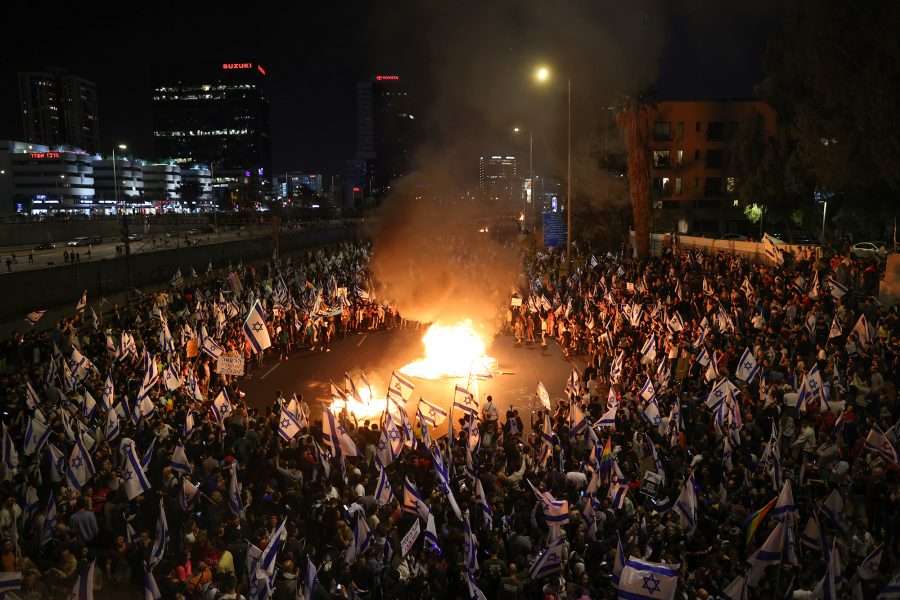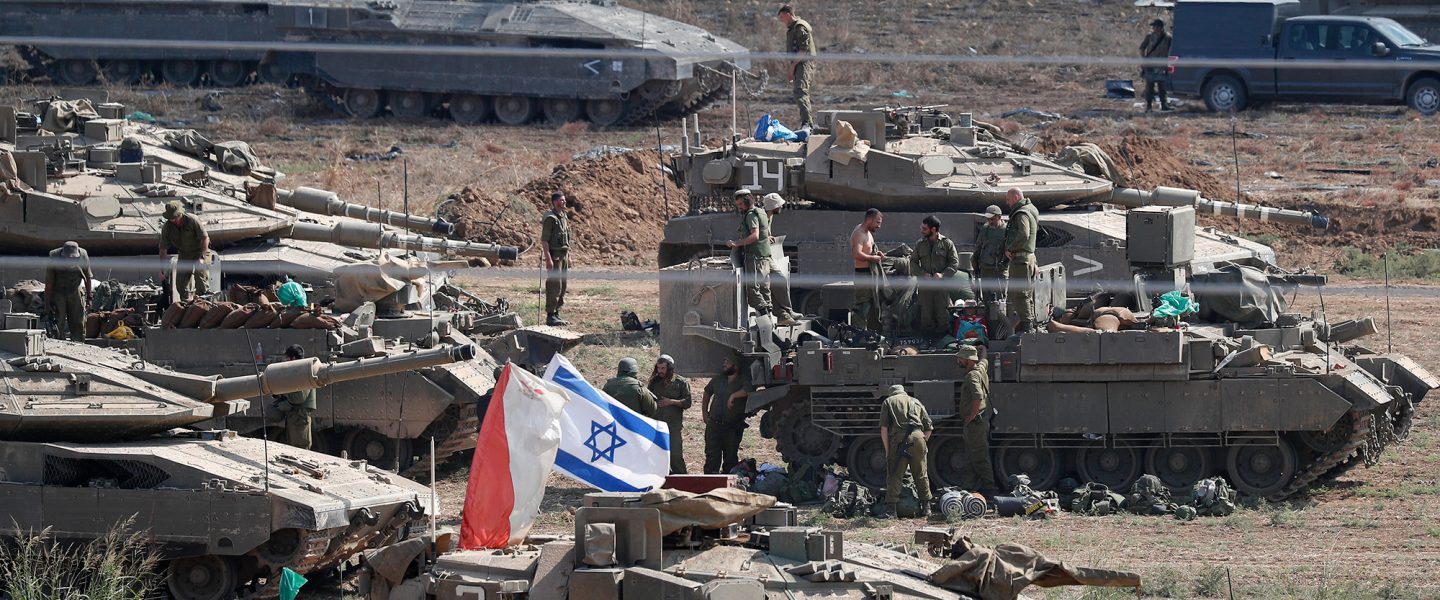Israel Moves Into Gaza
US Defense Secretary Lloyd Austin, in Tel Aviv, described Hamas as worse than ISIS. Will Israel’s retaliation be equally terrible? Does anyone really want that?
|
Listen To This Story
|
As more details emerge concerning Hamas’s bloody assault against Israel, Hamas’s actions are increasingly described as “bestial.” Israel’s defense minister, Yoav Gallant, said, in deciding to close Gaza off: “No power, no food, no gas, everything is closed. We are fighting human animals, and we will act accordingly.” Picking up on Gallant’s description, Israel’s ambassador to Germany, Ron Prosor, told Politico’s transatlantic podcast, Power Play, “This is about people who act like animals and have no respect for women or children.”
There is no question that the attack, in which among other atrocities Hamas’s fighters senselessly shot at women and little children, burning some alive and desecrating the corpses of others, was a heinous event that violated the fundamental rules underpinning human society. US Defense Secretary Lloyd Austin, arriving on the ground in Tel Aviv, told reporters: “Encountering ISIS, I felt as if we were staring evil in the eye, it was truly evil. In what we’ve seen from Hamas, it takes that evil to another level.”
The real question is: What does Israel intend to do about it? More to the point, will Israel’s retaliation turn out to be as inhuman as Hamas’s attack? In the days after, Israel bombed much of Gaza, knowing full well that the airstrikes were going to kill innocent civilians, including women and children.
Also at immediate risk were the hostages carried off to Gaza both as human shields and as future bargaining chips in negotiations over Hamas prisoners held in Israel. Hamas has claimed that at least nine have already been killed by the retaliatory bombing.
The indiscriminate bombing may have assuaged the anger in Israel, but it did nothing to make the situation better.
It recalled the lines of French writer and humanist philosopher Albert Camus in his “Letter to an Algerian Militant,” referring to France’s war over Algerian independence. “Whatever the cause being defended,” Camus wrote, “it will always be dishonored by the blind slaughter of an innocent crowd when the killer knows in advance that he will strike down women and children.” By week’s end, Israel had done just that. The anger and passion were understandable. The deeper question was what had it really accomplished?
The other nagging question was: What did Hamas really want? The explanation may be as simple as an end to a decades-old, hopeless stalemate that left millions in misery. The Economist quoted a Hamas representative as saying, “Either we die slowly or we die taking the occupation with us.” That, in fact, could be Hamas’s longer-reaching plan.
Hamas would not be the first fanatical organization to see “suicide by cop” as a final desperate tactic. Whether or not the leaders of Hamas have suffered personally, the lingering injustice of an entire people virtually imprisoned on a narrow slip of territory and deprived of the land that their ancestors lived on for generations provides a reservoir of talent that fanatical extremists can draw on at will.
Hamas might seem to be unmitigated evil in Western eyes, but plenty of people on the short end of globalization see the post-colonial poverty and inequality that they have largely suffered as a slow-motion death largely ignored by the rest of the world.. Richer nations might ignore the festering inequality, but eventually, patience runs out. In the popular TV series The Queen, depicting the life of Elizabeth II, Prince Philip warns if you ignore reality too long, you end up with a rebellion and your head on a pike.
In a rush of apparently genuine sympathy, President Joe Biden promised Israel undying support. Biden’s blank check to Israeli Prime Minister Benjamin Netanyahu seemed understandable given the heated emotions of the moment, but it may have been premature. It risks associating the US with whatever Netanyahu’s already controversial government finally decides to do.
Biden’s promise of support also comes at a time when the US is seen internationally as increasingly erratic. Promises are fine, but what happens if Trump is reelected? Divisions among Republicans in Congress and threats to stop funding Ukraine have exacerbated doubts that the US can still be fully trusted as an ally.
The added complication is that Netanyahu is largely responsible for creating the current sense of unrest in Israel. The country has been polarized because Netanyahu felt forced to include a minority group of ultra-nationalists in his coalition government in order to obtain a majority in the Knesset, Israel’s parliament. Rash statements by extremists in his coalition have set liberals on edge. Encouragement to Israeli settlers to grab as much territory as they can in the West Bank’s occupied territories, which at least technically still belong to Palestinians, has stirred even more resentment.
Netanyahu’s efforts to award himself the power to override and otherwise ignore Israel’s Supreme Court and judiciary have rattled the core of Israel’s confidence in itself as a genuine democracy. Protests against Netanyahu have been raging in the streets for the last nine months. Two months ago, several thousand reservists in Israel’s Defense Force, the IDF, refused to show up for training. While insisting that they remain loyal to the country, they did not feel that they could defend the dictatorship that Netanyahu appeared to be interested in creating. Air Force pilots, a key element in Israel’s defense, also objected to Netanyahu’s attempts to disempower Israel’s rule of law.

Netanyahu’s desperate attempts to cling to power after 20 years in office have left Israel badly divided and, in the eyes of many, less able to defend itself. In the judgment of critics, it is not just that Israel was taken totally by surprise, but also that it took the army anywhere from 10 to 12 hours to reach many of the settlements under attack.
Rep. Michael McCaul (R-TX), who heads Congress’s Foreign Affairs Committee, told a press conference in Washington following a classified intelligence briefing that Israel had been warned three days in advance that an attack was likely. “We have warned them an explosion of the situation is coming, and very soon, and it would be big,” an Egyptian intelligence officer told the Associated Press, “But they underestimated such warnings.”
At least some Palestinians will no doubt question whether Netanyahu might have known of the attacks but said nothing, calculating that outrage following a series of atrocities by Hamas would give Netanyahu the ammunition he needed to seize total control of the West Bank and Gaza. The Middle East is especially prone to conspiracy theories, owing to the opaque decision-making of most governments in the region. A theory doesn’t have to be true to be believed. For his part, Netanyahu vehemently denies any knowledge of Hamas’s attack plans or of any warnings coming from Egypt.
What is clear is that the onslaught represents a new and frankly innovative approach to insurgent warfare. Instead of sophisticated weaponry, Hamas relied on inexpensive drones, motorized hang gliders, motorcycles, and pickup trucks to overwhelm Israel’s defenses. The new approach mirrored a number of techniques that have already become commonplace in the war in Ukraine. Iran produced the inexpensive Kamikaze drones that Russian troops increasingly rely on.
After the attack in Israel, Hamas broadcast a video of one of its drones knocking out an Israeli Merkava Mark IV tank, the most sophisticated and effectively armored tank in Israel’s arsenal. A Merkava Mark IV costs the IDF $3.5 million. The drone that destroyed the tank probably cost Hamas a few hundred dollars. The video shows the drone hovering over the tank, then dropping an explosive charge that destroys the tank. The drone lived to tell the story.
Another Hamas video shows a drone hovering over a tower housing a remote-controlled Israeli machine gun. Seconds later, the drone drops a grenade that demolishes the Israeli installation.
It’s no secret that Iran has been manufacturing inexpensive kamikaze drones for Russia to use in Ukraine, and it’s also no secret that Iranians met with Hamas in Beirut shortly before the attack. What seems fairly certain is that the nature of warfare is changing quickly, and effective defense against future attacks will require a rethink.
As for Israel’s planned retaliation, at least one painful consideration is the fate of the estimated 150 hostages that Hamas planned to use as human shields in Gaza. Bezalel Smotrich, Netanyahu’s finance minister, advised smashing Hamas and not worrying too much about the hostages. That captured the early mood immediately after the attack and it seems to be what Netanyahu has in mind.
Israel ordered roughly a million residents of Gaza to move toward the south before the Israeli army begins to clear out the north. The problem is that Gaza, a tiny strip of land, is only 25 miles long and covers just 140 square miles. Most people have literally no place to go. Egypt has sealed its borders, and the last thing it wants is an influx of 2 million refugees.
If Israel invades and demolishes what remains after a solid week of bombing, it will create a human catastrophe that will very likely alienate just about everyone in the Arab world and many elsewhere. That could make continued support from the US and Europe untenable, which may be what Hamas hopes for. Netanyahu might do well to remember a comment made by a British soldier dealing with uprisings in Aden in the 1960s: “The best weapon in an insurgency is a knife.” In other words, be selective and careful about who it is that you end up attacking.




